
Originally published on the WeChat public account Unitimes (ID: Uni-times)
Author: Michael McGuiness
Thanks to Justin Drake for inspiring many ideas in this article and for reading the draft.
For years, I have believed that Bitcoin has the most asymmetric risk-reward profile of our lifetime. Its unique properties make it the best store of value in the world. Its difficult-to-replicate network effects make it unlikely that any other cryptocurrency can replace it.
By September 2020, Bitcoin was the only cryptocurrency I held. Its total addressable market (TAM) as a store of value was so vast that allocating capital anywhere else seemed pointless. The broad market for value storage could be as high as 400 trillion dollars, and what shocked me was that Bitcoin was very likely to capture a significant portion of the “currency premium” from the following:
-
Gold ($10 trillion)
-
Bonds ($100 trillion)
-
Stocks ($30 trillion)
-
Real Estate ($200 trillion)
-
Broad Money ($100 trillion)
-
Art, Wine, Collectibles ($20 trillion)
I previously thought, what could possibly compete with this advantage? Furthermore, most other cryptocurrencies are scams, and the few legitimate projects seem to have not yet found product-market fit.
Then, at a friend’s urging, I reluctantly started buying some ETH. Don’t get me wrong, smart contracts and decentralized applications (Dapps) are cool. But at that time, it seemed to me that Bitcoin would win the use case for store of value, which was the expected outcome and the ultimate reward. I was also unsure how Ethereum’s native asset (ETH) would appreciate.
A few months ago, my perspective began to change. Almost everyone in the crypto space can attest that once you own something, you become more invested in it. (Ethereum) had two developments that caught my attention: 1) Ethereum’s transition to Proof of Stake (PoS); 2) the changes in the protocol’s monetary policy. I quickly realized that these changes would have a significant impact on ETH’s monetary properties, potentially making it a better store of value than BTC.
Of course, I was initially skeptical. After all, Bitcoin had such a huge lead. It is a household name, the most secure in terms of network hash power, and large institutions like Tesla, MicroStrategy, and MassMutual have begun adopting it as a reserve asset. Can Ethereum really catch up?
But the more I read and thought, the more I believed in the possibility of ETH as a store of value. I soon converted most of my BTC into ETH and decided to write this article to clarify my thoughts.
In my view, Ethereum will win the battle for store of value for four main reasons:
-
More Scarce
-
More Secure
-
Organic Demand
-
Actual Yield
I realize that such a suggestion may be seen as blasphemy by Bitcoin maximalists. I support these maximalists in many ways, such as the demand for a new asset that allows people to store their wealth over time. However, I am less dogmatic about how to achieve this. I will ultimately support the asset I believe has the highest probability of success. To borrow a phrase from Paul Tudor Jones, Ethereum now looks like the fastest horse.
01. More Scarce
In my previous article, “Why Bitcoin Makes Sense” (Why Bitcoin Makes Sense)[1], I wrote extensively about what constitutes a good store of value, so I won’t spend too much time discussing definitions here.
The basic premise is that money is just a technology that allows us to consume today’s wealth tomorrow. Therefore, over time, the “best” money will provide the greatest purchasing power to its holders. Several factors affect the suitability of a monetary commodity as a store of value, but the most important factor is supply growth or scarcity.
Have you ever wondered why gold has been the primary store of value in human history? Why not silver, copper, or one of the other 118 elements? The main reason is scarcity. The annual growth rate of gold supply has historically hovered around 2%. Only silver has an annual growth rate that can reach 5-10%, currently around 20%. The extremely low supply growth rate allows gold to retain its purchasing power better than anything else over time, and the world eventually recognized gold as a store of value.
For thousands of years, gold has been the best (store of value) we could use because it is a limited-supply monetary commodity that can retain its value over time. However, the invention of Bitcoin created the first truly scarce form of currency in history. Bitcoin has a precise supply limit of 21 million coins, and anyone can audit this with their home computer. Bitcoin takes what gold has done better than anything else and makes orders of magnitude improvements on top of that. However, Ethereum may also do the same to Bitcoin by transitioning to Proof of Stake (PoS) and upcoming changes to its gas management.
2. Ethereum’s Monetary Policy & EIP-1559
Currently, Ethereum’s annual network issuance (i.e., inflation rate) is about 4.5%, with 2 ETH per block, and an additional reward of 1.75 ETH per uncle block (plus fees) for miners. Ethereum does not have a fixed supply because a fixed supply also means a fixed network security budget. Rather than arbitrarily fixing Ethereum’s security, its monetary policy is best described as “minimum issuance to ensure network security.”
Bitcoiners (Bitcoin supporters) hate this ambiguity because they believe that the underlying financial system should be stable. Bitcoin’s development is intentionally cautious and slow, with a total issuance capped at 21 million coins.
But the Ethereum community believes in sacrificing short-term (issuance) stability for long-term network security, and the fact is that Ethereum has a history of reducing issuance to an estimated minimum level. Moreover, the transition to PoS will significantly reduce ETH issuance while maintaining the same level of network security. I will elaborate on this later, but Vitalik has a great article[2] explaining how PoS can provide more security at the same cost.
According to the current Eth 2.0 specification, as part of PoS, Ethereum’s issuance rate will be greatly reduced.New ETH issuance will be generated by validators who stake ETH by processing transactions and reaching consensus on the network status, rather than being given to miners, and there will be a floating ratio between the total staked ETH and the annual interest rate for stakers.
The current specification will produce the following annual interest rate and inflation rate based on the network’s total staked ETH:
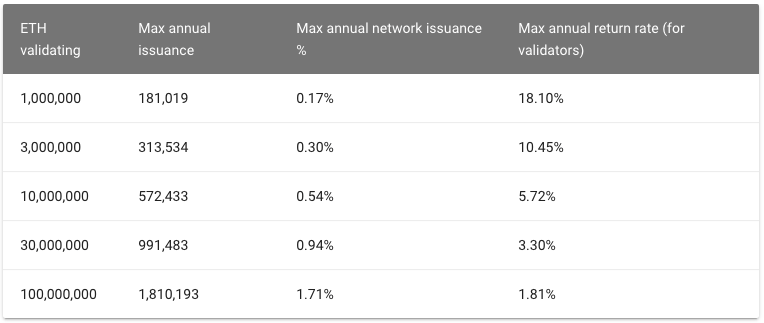
Essentially, we can expect that after the PoS transition, the annual network issuance (i.e., inflation rate) will drop from today’s ~4.5% to below 1%. The chart below highlights this massive decline:

However, this (inflation rate) is still higher than Bitcoin, which has a cap of 21 million BTC and a long-term inflation rate of 0%. So, how will Ethereum become more scarce? Well, there’s more. With the release of Ethereum Improvement Proposal EIP-1559, Ethereum has begun addressing many concerns about its monetary policy, which is referred to as “the scarcity engine of Ethereum” or “the ETH burning mechanism.”
EIP-1559 will be implemented this July as part of Ethereum’s upcoming London hard fork. Diving into the details of this proposal goes beyond the scope of this article, but the key aspect to note is that in addition to improving the user experience for Ethereum gas fees, EIP-1559 will burn (destroy) a portion of ETH transaction fees. This will permanently remove some ETH supply from circulation and reduce ETH’s daily net issuance.
An analysis of network transactions last year showed that EIP-1559 would burn nearly 1 million ETH within 365 days, which is almost equivalent to 1% of the entire network’s circulating supply. As Ethereum transaction demand grows, many expect this number to increase over time. Therefore, when combined with the lower issuance rate brought by PoS (below 1%), Ethereum will actually have a deflationary monetary policy.
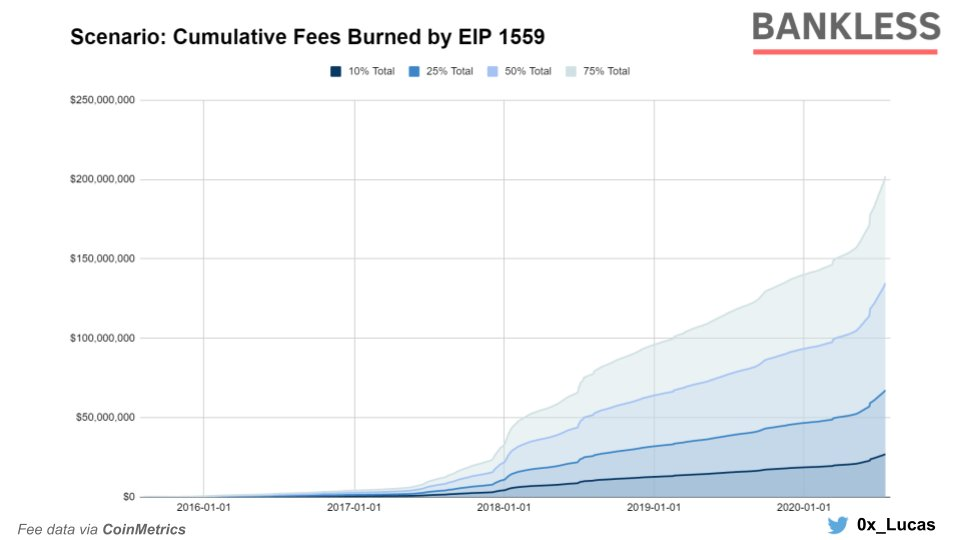
This has led to the emergence of a new meme in the Ethereum community called “ultrasound money” (ultra-sound money), created by Ethereum researcher Justin Drake. This term is a bit silly, but Drake’s point is that if Bitcoin is considered “sound money” due to its capped supply of 21 million, then a cryptocurrency with a gradually decreasing total supply should be even better, hence the term “ultrasound money.”
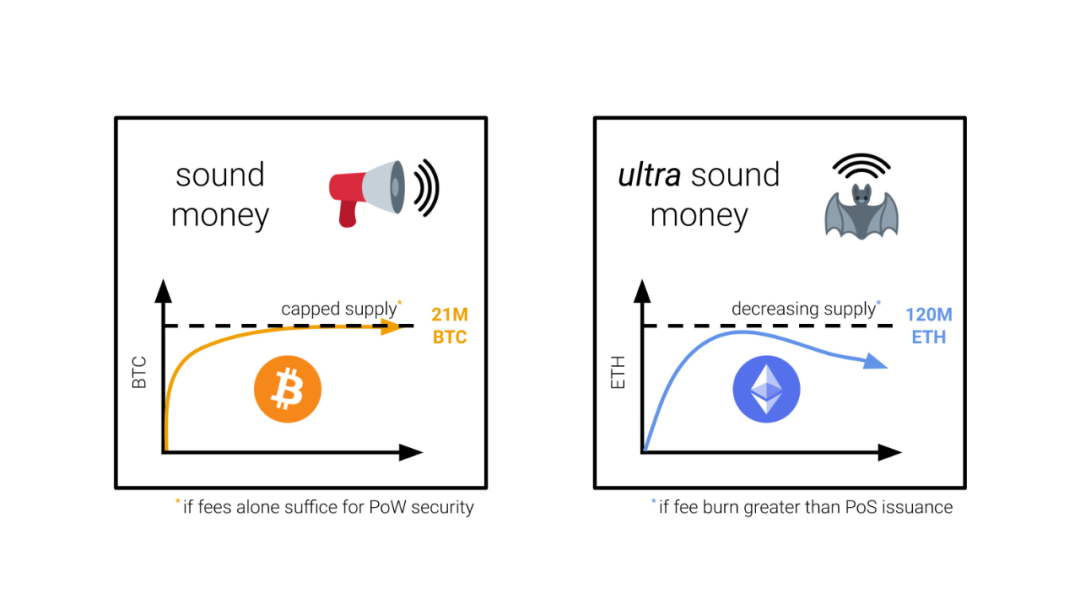
In the long run, Ethereum will be a more scarce asset. However, I might be more bullish on the short term. With the removal of PoW, ETH issuance will drop by about 90%. According to estimates, this has an impact on (Ethereum) miner sell pressure equivalent to three Bitcoin “halvings.”
3. Stock-Flow Ratio & Migration to PoS
To quantify Bitcoin’s scarcity and use it for Bitcoin’s value modeling, the best attempt comes from PlanB’s stock-to-flow model (stock-to-flow ratio model)[3]. Essentially, PlanB believes that scarcity (defined as the supply growth rate) directly drives value; the scarcer an asset is (i.e., the lower the supply growth rate), the more valuable it becomes. Below is the chart he created to prove his point (where “SF” stands for “stock-to-flow,” calculated inversely to the supply growth rate):
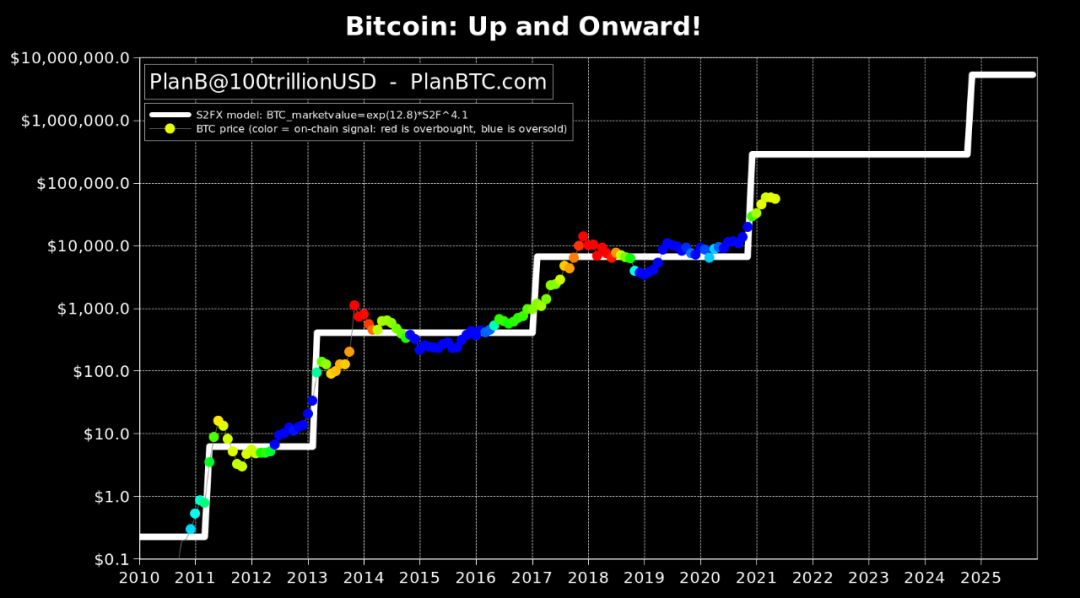
Note: SF = Stock / Flow; Supply Growth Rate = Flow / Stock. The stock of an asset is the total number of that asset currently in circulation in the market; flow is the amount of that asset newly added to circulation each year..
Shockingly, this SF model has maintained remarkably well over the two years since it was published. In the chart below, the white line represents the predicted price of BTC, while the multicolored dots represent Bitcoin’s price performance up to May 2021.
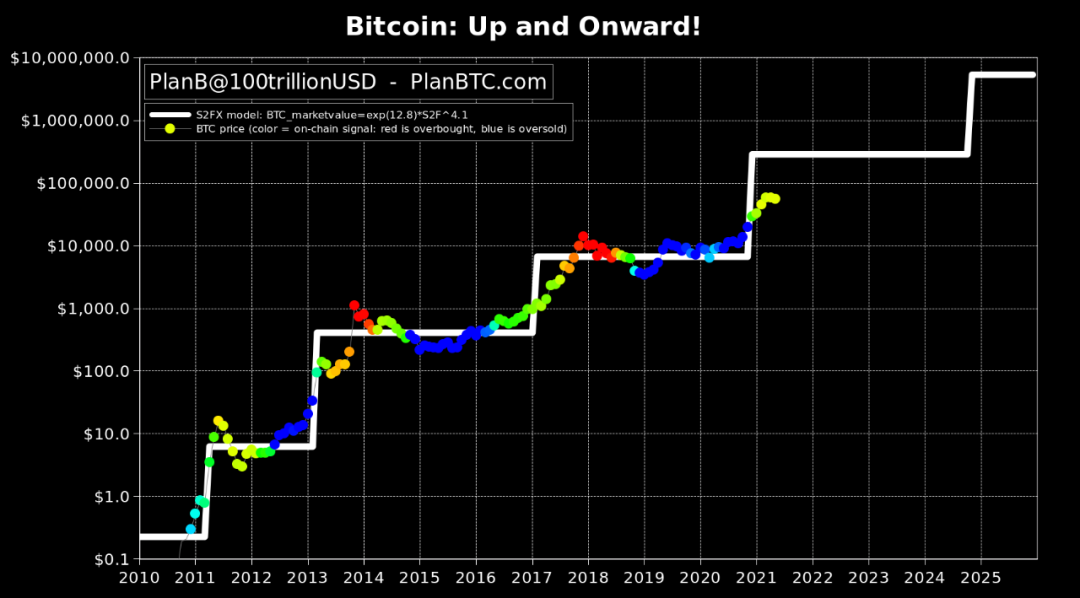
As we can see, based on this model, Bitcoin’s value has significant jumps every four years. This is because the block rewards paid to Bitcoin miners halve every 210,000 blocks (approximately every four years). Since block rewards are the only way to mint new bitcoins, the supply growth of Bitcoin is reduced by half every four years.
As PlanB has elucidated (and quantified) in his article, the decline in Bitcoin’s supply growth (i.e., halving) is highly correlated with the surge in Bitcoin’s price. This may be because halving directly reduces miners’ sell pressure. Because Bitcoin uses a resource-intensive PoW consensus mechanism, miners must sell Bitcoin to cover their hardware and electricity costs. Therefore, when Bitcoin’s block reward halved from 12.5 BTC per block to 6.25 BTC in May 2020, miners’ sell pressure dropped from 1800 BTC per day to 900 BTC per day. This means that miners reduce the BTC sold each year by an amount equivalent to about 1.6% of Bitcoin’s market cap (around $18 billion at today’s prices). Under such a massive supply shock (decline), we naturally see BTC prices soar until a new equilibrium level is reached based on this reduced inflation rate.
Ethereum is currently also using a PoW consensus mechanism. However, when it fully transitions to PoS, the current annual ETH issuance of about 4.5% will drop to below 1%. This is equivalent to ETH miners reducing the sell pressure of ETH by about 3.5% of its market cap annually (over $15 billion at today’s prices). Moreover, I expect the sell pressure to be even lower because block rewards will be allocated to stakers (validators) who do not need to be forced to sell (ETH) due to their very low hardware and electricity costs. However, to be fair, most stakers will still have to sell some ETH to pay taxes on the rewards they earn, so the new ETH market supply will not become zero.
Of course, in addition to scarcity, there are many other factors driving the value of an asset. The degree to which it is accepted by others is one such factor. However, scarcity (at least for now) seems to be the most important factor affecting the value of commodity money, as it influences sales over time. On the other hand, security is also a crucial factor. Just as gold does not rot, corrode, or undergo other types of degradation, cryptocurrencies must have appropriate incentive designs to endure. After all, an asset that no longer exists decades from now cannot serve as a store of value.
02. More Secure
Holding gold, you don’t have to worry about security issues. From unforgeability to double-spending, the laws of physics apply to it. However, when it comes to cryptocurrencies, you must constantly incur costs (i.e., pay block rewards to miners/validators) to ensure network security.
Take the Bitcoin network, for example; a new block is created every 10 minutes. Each block contains newly minted BTC (i.e., “block subsidy, currently 6.25 BTC per block) and transaction fees, which together constitute the “block reward.” According to Bitcoin’s hardcoded monetary policy, the amount of newly minted BTC per block decreases over time (halving every four years), eventually reaching 0% by the year 2140. When this happens, with no new bitcoins being issued, the only compensation for miners will be transaction fees.
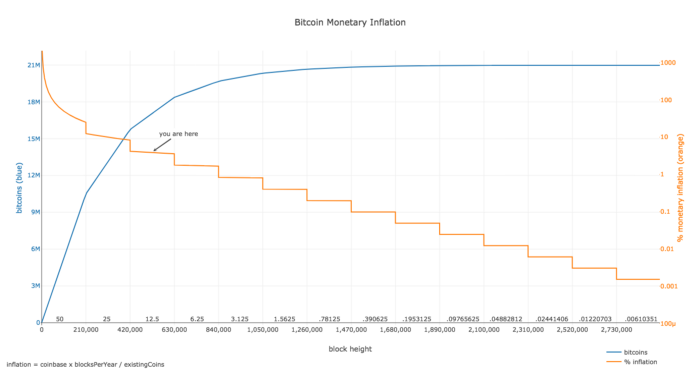
Many Bitcoiners (Bitcoin supporters) believe this will not be a problem because when the block subsidy runs out, the dollar value of transaction fees will be very high, thus (the Bitcoin network’s) security expenditure will be sufficient to ensure network security. Bitcoin supporter Dan Held wrote in his article “Bitcoin’s Security is Fine” (Bitcoin’s Security is Fine)[4]:
“I suspect that, in dollar present value terms, several hundred billion dollars should be enough of a security budget, because for a government, it is hard to justify such an expense just to attack the Bitcoin blockchain. They would also have to publicly respond to such an attack because their citizens (taxpayers), businesses, and banks would all have invested in Bitcoin.”
He then addresses some of the concerns often raised about relying solely on transaction fees for (Bitcoin) network security in that article. I agree with Held‘s many points and understand why Satoshi designed Bitcoin this way. With the PoW mechanism, there is always a trade-off between inflation (block subsidies) and security. Bitcoin has made specific trade-offs, and it will continue to pay less and less to its consensus engine (i.e., lowering block subsidies) to maintain scarcity and limit Bitcoin’s quantity to 21 million.
However, I disagree with Held’s view that this dollar-denominated security expenditure is crucial, and I support Vitalik Buterin‘s recent post on reddit[5] where he wrote:
“The security demand of a thing must be proportional to its size, because as a thing grows, its enemies also grow larger and their motivations become stronger. If BTC (its market cap) were 100 times what it is today, then the value (cost) to destroy it would increase 100 times, and those who want to destroy it would become larger and more fearsome. This is why the military size of all countries is roughly proportional to their GDP. Therefore, in reality, the cost of an attack divided by the market cap is the correct metric to measure; in the long run, (ultimately) not issuing (new coins) PoW does not seem as good.”
So let’s look at Held‘s most optimistic scenario, where Bitcoin “survives, thrives, and continues to grow its market share exponentially, just as it has over the past 10 years.” In this hypothetical scenario, Bitcoin’s market cap in 2140 would be $100 trillion, and (users) would generate $365 billion in transaction fee revenue for miners due to the demand for Bitcoin block space (which would be the security expenditure for the Bitcoin network). See the chart below:
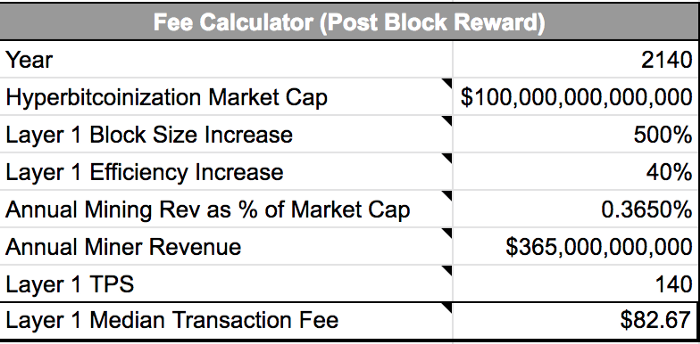
Does $365 billion in security expenditure really suffice to protect the Bitcoin network from attacks? Maybe. I’m really not sure, and I don’t know what the world will look like in 2140. However, I’m quite sure we can do better. In the above hypothetical scenario, Bitcoin’s PoW consensus mechanism would make its value-to-security ratio (the ratio of Bitcoin’s market cap to its annual security expenditure) about 273 to 1. Meanwhile, under Ethereum’s PoS consensus mechanism, we could get its value-to-security ratio to about 10 to 1. If Ethereum’s market cap matches Held’s projected Bitcoin market cap, the cost of launching a 51% attack on the Ethereum network would be approximately $10 trillion, which is over 27 times the cost of the $365 billion predicted for Bitcoin, with the only assumption being that about 10% of ETH is staked, which seems reasonable; meanwhile, Held’s prediction assumes a 500% increase in Bitcoin block size, a 40% increase in efficiency, and huge demand for Bitcoin block space.
In addition to the much lower value/security ratio (Note: the lower the value/security ratio, the higher the cost of an attack), Ethereum has a major advantage in how it responds to attacks. After a 51% attack, the only option for the Bitcoin network is to switch from its current Double SHA-256 ASICs to a new PoW system. This new system would have to be based on commercial mining hardware, such as GPUs or CPUs, as there would not be enough time to manufacture hardware for another ASIC PoW system. The attacker can then conduct the same 51% attack on ordinary hardware.Vitalik calls this a “nesting attack” (spawn camping attack), where a miner alliance that initiates a 51% attack continuously attacks, rendering the chain useless. In PoW systems, there is no way to destroy (or punish) the attacker’s mining capability.
Ethereum (and the broader PoS) is less susceptible to such attacks. This is because the Ethereum network can “slash” or punish attackers. If an attacker does something wrong, the network will penalize them by seizing their staked ETH. This is equivalent to Bitcoin destroying the attacker’s mining equipment, which is something the protocol clearly cannot do.
Ethereum actually has two slashing mechanisms. The first can be called “Layer 1” slashing, which triggers if you (validator) do something obviously wrong in the protocol (e.g., submit two conflicting proofs), in which case, the Ethereum network will automatically slash at least one-third of your staked ETH. This will address most potential attacks and redistribute ETH from dishonest nodes to honest nodes, making the system somewhat antifragile. If you look at it from the perspective of game theory, the Ethereum system becomes stronger with each attack.
Assuming the attacker wants to attack again. They must acquire more ETH, attack again, and then be slashed again. Each time an attack occurs, the circulating supply of ETH decreases, so the number of times the system can be attacked is effectively limited. For instance, if there are currently 100 million ETH in total, and 10% is staked. For each attack, the attacker would need to buy at least 10 million ETH, and each time they are slashed, they would have to reacquire another 10 million ETH. In the worst-case scenario, the attacker can only attack the system 9 times. Additionally, the cost of each attack will increase because the price of ETH in the public market will likely rise as the supply decreases.
Similarly, this antifragility also exists at the level of single-game play. If you want to attack the Ethereum network, you must acquire 10 million ETH (using simplified numbers in the above example). Due to simple supply and demand dynamics, the more ETH you want to buy, the more expensive ETH will become as the available ETH for sale decreases, leading to diseconomies of scale (diseconomies of scale), for example, the cost of buying 1% of the ETH supply the second time will be higher than the first time because there is less ETH available for sale after you bought 1% ETH the first time.
To mitigate the fear of miners or mining pools gaining 51% of the hash power, a common argument (assumption) is: even if they gain 51% of the hash power, why would they attack? After all, attacking the network would destroy the “golden goose” that lays the eggs, which is not in their interest. But in reality, we cannot make such assumptions; this argument not only assumes rationality but also assumes no external incentives (outside incentives). The whole point of having a high security level is to prevent those with external incentives from breaching the chain. This is why Vitalik’s approach to thinking about PoS security is “If they (attackers) have X billion dollars, how many times can they breach this chain before all their funds are slashed?” This is not an assumption of rationality, but merely assumes that malicious actors have limited economic resources.
Perhaps the best argument I’ve heard in favor of PoW security is that its hardware-driven nature (mining machines) adds resistance to those capital-rich attackers: you need to wait a year for this hardware to be manufactured, which inevitably involves many people, and there is a high risk of being discovered during this process (i.e., as you gradually increase your hash power). This is the true advantage of PoW. That said, physical hardware also has a key disadvantage: it is hard to conduct large-scale mining without detection, while PoS is more resistant to censorship.
In terms of security, participating in Ethereum staking does not leave any “footprint,” which is a huge advantage: to become an Ethereum validator, all you need is ETH, a Raspberry Pi, an SSD, and an internet connection. This sharply contrasts with Bitcoin, where becoming a miner entails a huge “footprint”: miners need to consume massive energy and use large warehouses to store mining equipment. Such a “footprint” makes it relatively easy for governments to discover and shut down mining operations. In contrast, with Ethereum, you (the validator) can be anywhere in the world (perhaps even hiding your IP address through the Tor network). Even if a government could find and seize your physical equipment validating Ethereum, that equipment does not store the ETH you staked: ETH only exists in the digital world and can only be seized by forcing the owner to surrender their private keys.
People sometimes forget that when Satoshi Nakamoto created Bitcoin over a decade ago, it was the first successful attempt to create digital scarcity and incentive design for a PoW consensus system. While the pseudonym “Satoshi” is clever, this person (or team) is human and cannot reasonably be expected to foresee all the potential problems arising from Bitcoin’s incentive design. Since then, the blockchain space has undergone over 12 years of research and development in network security and scalability.
In my view, Ethereum seems to be a more secure network in the long run.
03. Organic Demand
In 1944, the Bretton Woods Agreement laid the groundwork for the near-global locking of the US to the international monetary system. However, just a decade later, the Bretton Woods system began to crumble. The US began to run massive fiscal deficits, and inflation levels began to rise moderately, first due to domestic projects in the late 1960s (when the US heavily developed its economy after WWII), and then due to the Vietnam War. Soon, the US’s gold reserves began to dwindle as other countries began to doubt the dollar’s backing and exchanged dollars for gold. The continued reduction of gold reserves ultimately forced Richard Nixon to end the dollar’s convertibility to gold in 1971.
After the collapse of the Bretton Woods system, every currency became fiat currency. This was the first time in human history that all currencies in the world were transformed into paper money without any backing. These currencies have no intrinsic value. They are valuable because the government declares them valuable and forces their use as a medium of exchange and unit of account, either by requiring that all taxes be paid in this currency or by enacting other laws that increase the barriers to using other media of exchange and units of account (or in some cases, completely prohibiting them).
However, outside of the US, foreign businesses and governments had little reason to accept (dollar) paper currency because this currency could be printed endlessly and had no solid backing. However, it turns out that the US created a sustained international demand for the dollar through the petrodollar system, forcing global adoption of the dollar.
In 1974, the US reached an agreement with Saudi Arabia. Saudi Arabia (and other OPEC members) would only sell oil for dollars in exchange for US protection and cooperation. For example, even if Germany wanted to buy oil from Saudi Arabia, they could only do so with dollars. From then on, any country wanting oil would need to use dollars to pay for it. As a result, non-oil-producing countries began to sell many of their export products for dollars so they could obtain the dollars they needed to purchase oil from oil-producing countries. All these countries would hold excess dollars as foreign exchange reserves.
Over time, this system has only strengthened. As Lyn Alden wrote in her excellent article “The Fraying of The US Global Currency Reserve System” (The Fraying of The US Global Currency Reserve System)[6]:
“At first, countries needed dollars to obtain oil. Decades later, as so much international financing occurred in dollars, countries now need dollars to repay dollar-denominated debts. Thus, the dollar is supported by oil and dollar-denominated debt, which is a very powerful self-reinforcing network effect. Importantly, most of these debts are not owed to the US (though they are dollar-denominated), but to other countries. For example, China provides many dollar-denominated loans to developing countries, as do Europe and Japan.”
It is this “self-reinforcing network effect” that has led everyone in the world to accept the worthless paper issued by the US government in exchange for tangible goods and services. This is absolutely the fundamental reason the dollar has become a global reserve asset. Why is this important? I believe that a similar system — and a virtuous cycle — is emerging around the Ethereum network.
For the past decade, the demand side of most crypto networks has been dominated by speculation. This is understandable. Speculation has funded the construction of the supply side of these networks (infrastructure, applications, etc.). But this is changing. You need to use ETH to do things on the Ethereum network, and people are doing a lot of things on this network: they are buying domain names, trading tokens, lending, issuing bonds, using prediction markets, making payments, buying insurance, purchasing art, gaming, buying virtual land in the metaverse, horse racing, and more. All these activities require using ETH to pay transaction fees.
As applications built on Ethereum become increasingly complex and intuitive for users over time, demand for Ethereum will grow. Among the top 100 crypto projects, 94 are built on Ethereum, with over 3000 Dapps and 200,000 ERC-20 tokens running on Ethereum. The total transaction volume on Ethereum reaches historical highs daily, and the average transaction value on Ethereum is more than twice that of Bitcoin.
Some of these numbers are indeed staggering. (As of writing) over $80 billion worth of ETH is locked in DeFi applications, up from $16 billion in January. In the past 12 months, decentralized exchanges (DEX) like Uniswap and Sushiswap have seen trading volumes reach $432 billion on Ethereum, as these automated market makers (AMM) have made token trading easier than ever. The supply of stablecoins on Ethereum has increased from $19.5 billion in January to over $48 billion today.
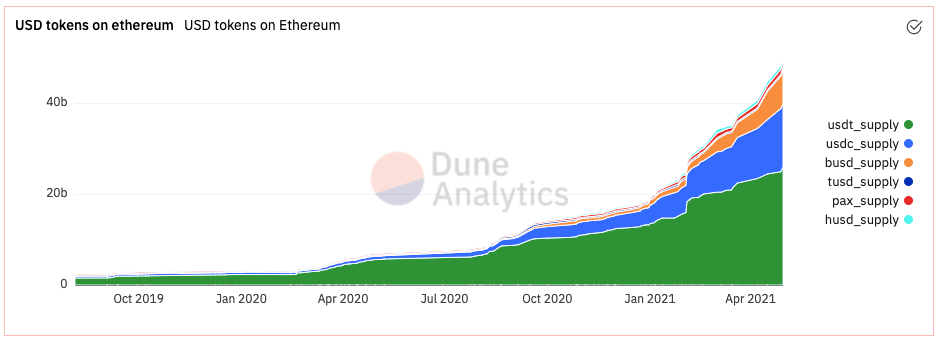 Above: The growth of various stablecoins supplied on Ethereum.
Ethereum is not only the settlement layer for almost all leading Dapps but also the settlement layer for the entire digital dollar ecosystem (i.e., stablecoins pegged to the dollar). Even traditional financial service companies like Visa are allowing transactions settled in USDC on Ethereum, indicating that stablecoins have now far surpassed traditional cryptocurrency use cases. Just weeks ago, the EU’s investment department used Ethereum to issue a two-year digital note worth €100 million ($121 million) for the first time.
Additionally, sales of NFTs (non-fungible tokens) on Ethereum have exceeded $600 million, with 13 NFTs selling for over $1 million each. The use cases for NFTs are exploding.
Above: The growth of various stablecoins supplied on Ethereum.
Ethereum is not only the settlement layer for almost all leading Dapps but also the settlement layer for the entire digital dollar ecosystem (i.e., stablecoins pegged to the dollar). Even traditional financial service companies like Visa are allowing transactions settled in USDC on Ethereum, indicating that stablecoins have now far surpassed traditional cryptocurrency use cases. Just weeks ago, the EU’s investment department used Ethereum to issue a two-year digital note worth €100 million ($121 million) for the first time.
Additionally, sales of NFTs (non-fungible tokens) on Ethereum have exceeded $600 million, with 13 NFTs selling for over $1 million each. The use cases for NFTs are exploding.
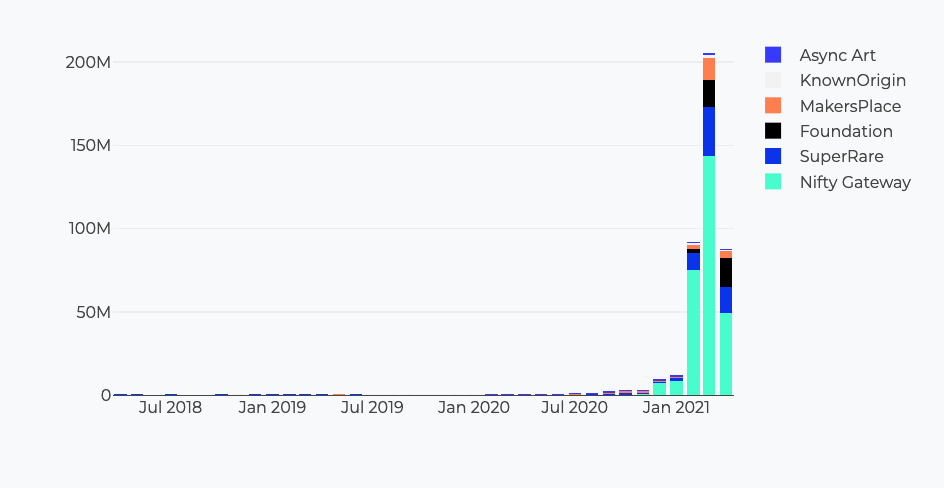
Similarly, if you want to interact with the Ethereum network in any of the above use cases, you must pay the miners/validators processing your transaction transaction fees. Ethereum is essentially a decentralized computer, and computational power comes at a cost. These fees are referred to as “Gas,” and the similarities to oil are astonishing.
The more useful the applications built on Ethereum are, the greater the demand for ETH will be. It is estimated that just in terms of cumulative revenue, the TAM (total addressable market) for DeFi reaches $2.7 trillion (2%-3% of global GDP). Understanding this makes it easy to see how a system similar to the petrodollar will develop around the Ethereum network. Let’s modify Lyn Alden’s quote above:
Initially, everyone needed ETH to use this global decentralized computer. Decades later, as so much international financing occurs in ETH, people will need ETH to repay debts denominated in ETH. Thus, ETH is supported by both computational demand and dollar-denominated debt, creating a very powerful self-reinforcing network effect.
Comparing the demand for ETH to the demand for oil may seem a bit far-fetched, but if the world’s financial infrastructure were built on Ethereum, would it still be far-fetched? In my view, ETH increasingly seems likely to benefit from a self-reinforcing network effect similar to what has made the dollar the global reserve currency.
Overall, Ethereum mimics Bitcoin in many ways but significantly expands potential use cases by creating a virtual decentralized computer, offering a substantial improvement. These use cases provide organic, sustainable, and growing demand for Ethereum block space. As these use cases flourish and gain wider adoption, demand will only increase.
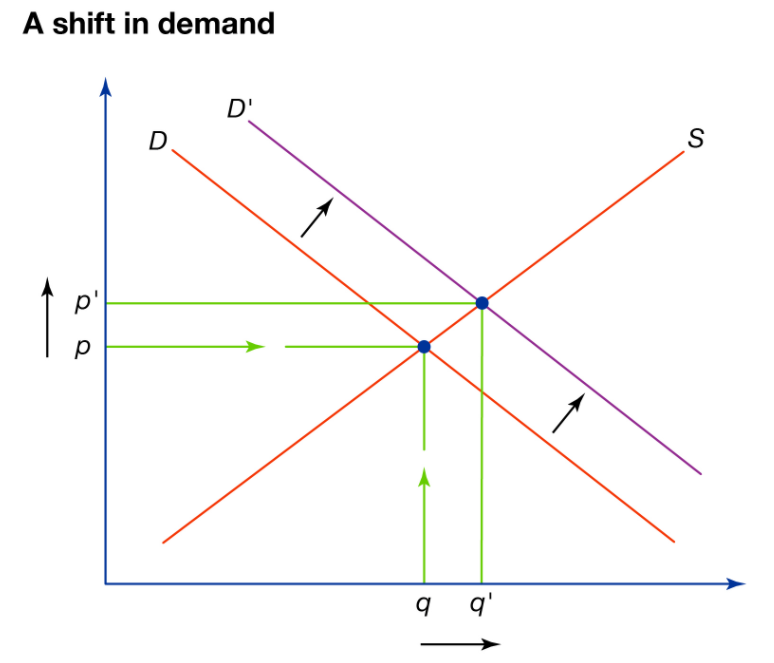
Since the “best” money provides the greatest purchasing power to its holders, this organic demand further increases the probability of ETH winning the store of value battle.
04. Actual Yield
Wall Street financial mogul George Soros may be one of the greatest forex traders in history. In his book “The Alchemy of Finance” (The Alchemy of Finance), he reveals much of his decision-making process. Chapter three is titled “Reflexivity in the Currency Market” (Reflexivity in the Currency Market), which describes the vicious and virtuous cycles in the currency market. In this chapter, Soros argues that there are some complementary factors in the traditional currency market that cause cycles characterized by significant fluctuations in exchange rates, interest rates, inflation, and/or levels of economic activity. This chapter is very technical, but let’s focus on the key drivers of speculative capital: rising exchange rates (exchange rates) and interest rates.
We emphasize speculative capital because it is one of the three major drivers of exchange rate movements (fundamentals), the other two being trade and non-speculative capital flows. In fact, “fundamentals” (the “more scarce” and “organic demand” factors we discussed in previous sections are also ETH’s fundamentals) are also influenced by market participants’ expectations about future exchange rate trends (i.e., the two influence each other). This is just an example of Soros’ “reflexivity” concept, which is easily observable in Ethereum: speculation drives many investors and developers to invest their time and money in building network infrastructure and applications on top of it. In fact, speculative capital is crucial to the fundamentals.
“Speculative capital seeks the highest total returns. (The factors affecting) total return are three: interest rate differentials, exchange rate differentials, and domestic currency appreciation. Since the third factor varies, we can state the following general rule: speculative capital is attracted to rising exchange rates and interest rates. Among these two factors, the exchange rate is the most important. A currency’s exchange rate does not need to drop much for total returns to turn negative. Similarly, when a currency that is appreciating also has interest rate advantages, total returns exceed any expectations of financial asset holders under normal circumstances.”
Let’s analyze this. The exchange rate (exchange rate) is the most important factor. This makes sense. If I stake ETH at 8.5% interest but the price drops by 10%, I lose money. So we really shouldn’t focus on interest rates until we can ascertain that the exchange rate will rise. This is why most altcoins with annual returns exceeding 1000% are poor bets, while Bitcoin has been such a great bet over the past 12 years. This is also why I emphasized the key factors driving ETH’s price increase in the first three sections of this article.
Let’s assume Bitcoin and Ethereum have equally compelling monetary properties, and the market expects both assets to appreciate by 100% this year. In this case, a rational investor should not have a strong bias toward either asset. However, if you allow the same investor to earn 6% interest by staking ETH (or let them run a validator node for 8%+ interest), the situation begins to change. While the expected return rate of 100% for (BTC) and 106% for (ETH) may not seem very different, over the long term, this will make a huge difference. As the speculation in cryptocurrencies decreases, the market becomes more efficient, and the expected appreciation of assets will drop to more reasonable levels, which is especially true. Over time, this additional 6% staking yield may constitute an increasingly larger proportion of ETH’s expected total return.
By staking ETH, you can earn an additional 6%+ risk-free staking yield, which will incentivize some investors to shift funds from Bitcoin to Ethereum. This is how the market works. For example, since 2008, the inflow of foreign capital into the US has reached about $8.5 trillion, most of which has increased since 2011, as investors sought higher returns in the form of arbitrage (the bond yields in the US were higher than the zero or negative yields in Europe and Japan). Speculative capital naturally flows to the assets with the highest expected real returns.
Ethereum’s virtuous cycle will create a vicious cycle for Bitcoin. As more speculative capital flows from Bitcoin to Ethereum in search of higher actual yields, the expectations for the exchange rate between the two currencies will also change. This will not happen overnight, but over time, I expect the market’s expectations for Ethereum’s price appreciation to exceed that of Bitcoin. When this happens, Bitcoin may be in a precarious position. As Soros wrote:
“The longer a virtuous cycle lasts, the more attractive financial assets that hold appreciating currencies become, and the more important the exchange rate is in calculating total returns. Those who tend to counter the trend will gradually be eliminated, and ultimately only trend followers will survive as active participants. As speculation becomes increasingly important, other factors lose their influence. The market itself, which is dominated by trend followers, guides speculators. These considerations explain how the dollar can continue to appreciate in the face of expanding trade deficits.”
I love Bitcoin and everything it represents, but this scenario seems increasingly likely to unfold. I wonder what will happen if Ethereum’s market cap surpasses Bitcoin’s for a period of time. If Bitcoin is not the most liquid asset in cryptocurrencies, what asset will it be?
Another aspect I won’t spend too much time discussing is that for most large ETH holders, staking ETH and yield farming in DeFi will be enough to provide passive daily income. They no longer need or want to sell ETH because they can earn passive income of 8%+ from staking rewards and even higher yield farming returns. This will further enhance Ethereum’s scarcity and future price expectations.
05. Risks & Concerns
In summary, these four factors (more scarcity, more security, organic demand, actual yield) are the primary reasons I believe Ethereum will ultimately win the store of value battle. Of course, my conclusions above are not deterministic, and if this article does not discuss some of the risks involved, it would not be complete. Since this article is already lengthy, I will briefly comment on each risk.
1. Scalability Challenges
Currently, when the (Ethereum) network is busy, transaction speeds are affected, resulting in poor user experiences for certain types of Dapps. As the network becomes busy, gas prices rise as transaction senders bid against each other. This makes using Ethereum very expensive. A few months ago, the gas price for completing a simple transaction reached as high as $100-200, but with the Berlin upgrade, prices have decreased, coinciding with ETH reaching new all-time highs.
This may be Ethereum’s most critical risk because it opens the door for competing projects, such as Solana, which is doing some interesting things in this space. But ultimately, Ethereum has many options to improve the speed, efficiency, and scalability of the network.Layer 2 solutions andsharding may be the most notable. However, they are not without technical risks, and they are urgently needed.
2. Other Layer 1 Solutions
I can’t help but wonder if Ethereum will eventually be replaced by a cryptocurrency that learns from Ethereum’s experiments and improves on some fundamental aspects. There are many “Ethereum killers” trying to capitalize on Ethereum’s weaknesses to become the leader, including Polkadot, Solana, Cosmos, Cardano, and others.
As Peter Thiel (billionaire venture capitalist) explained in a Stanford entrepreneurship lecture, “People often talk about ‘first-mover advantage.’ But focusing on this can be problematic; you might be ahead of the curve and then slowly fade away. More important than being a first mover is being a fast follower. You must have staying power.”
Two years before Amazon (Amazon) was born, there was Book Stacks Unlimited (an online bookstore). Four years before Google, Yahoo! (Yahoo) created the first global search engine. Before Facebook appeared, MySpace dominated social media. There are countless examples like this in tech history: first movers generate interest in a concept or product, and then fast followers seize the opportunity to improve on existing products.
However, Ethereum has strong protections against this obsolescence risk. It has many of the same network effects as Bitcoin, and the Ethereum community and protocol are innovation-friendly, which may be equally important. The meme “Bitcoin will absorb all innovation” has never materialized. In fact, Ethereum has the opportunity to do this, largely because they have “functional escape velocity” at the EVM layer.
While I acknowledge that constant adaptation to new developments and risks in this field is necessary, Ethereum currently appears to be the best choice.
3. Stability of Monetary Policy
Bitcoin may be the most unchangeable crypto system ever. Bitcoiners believe this is where Bitcoin’s true value lies. It is a reliable neutral system based on code (rather than humans), and you can rely on it for decades.
Ethereum’s human-managed hard forks and relatively centralized development team bring risks. How can we trust that Ethereum’s monetary policy will not change again? How can we ensure that an adverse (protocol) change will not occur? Even if the Ethereum community agrees that it will never change and respects that, it will always lag behind Bitcoin’s 12 years of established trust.
If Ethereum is to become a global store of value, this is an important question, but as mentioned above, I believe Ethereum is sacrificing short-term (monetary issuance) stability for long-term security. Ethereum is already highly decentralized, and its relatively centralized aspects allow them (the Ethereum development team) to innovate regarding security, monetary policy, and effectiveness.
As is almost always the case in (protocol) design, the transition from PoW to PoS comes with trade-offs. The first is complexity. Bitcoin’s PoW system is very simple; you can write pseudocode for it in a few dozen lines. However, Ethereum’s PoS is much more complex. The state transition mechanism of the beacon chain may have been written in about 1000 lines of code, so we will see complexity increase by about 100 times. This is a very real trade-off — complexity leaves room for bugs and may lead to scalability issues and other problems. But the good news is that Ethereum has managed this complexity well, as evidenced by the four production-level (client) implementations that are currently protecting the beacon chain.
Some people believe that Bitcoin is “monopolistic in fairness” because, at its launch, no one knew what it would become. They believe this is something that cannot be replicated and gives Bitcoin some of its best attributes. Anything with a pre-sale cannot be considered fair. Additionally, Bitcoin’s PoW system is a great enforcement mechanism for BTC distribution because miners must sell Bitcoin to pay for their hardware and electricity costs. PoS does not have this attribute. Ethereum’s stakers will only accumulate more ETH and will not be forced to sell ETH because PoS is very efficient, and hardware and electricity costs are very low. Therefore, Bitcoiners believe that PoS will establish a permanent wealthy ruling class.
However, as mentioned above, this is a misunderstanding because income tax (which is about 50% in many jurisdictions) will play an economic enforcement role. Moreover, Ethereum has been using a PoW system for nearly 6 years, and many Ethereum supporters believe it has already achieved a good distribution of ETH. Furthermore, do most market participants really care about whether the network is fair? I would argue that most of them act out of self-interest, buying any asset they believe will make them the most money. Also, who can decide what constitutes a fair distribution and what does not?
Note: This article only represents the views of the original author, and the translation has been slightly abridged. The original English text can be found at:
https://michaelmcguiness.com/essays/why-eth-will-win-store-of-value
The links referenced in the text:
[1]:https://michaelmcguiness.com/essays/why-bitcoin-makes-sense
[2]:https://vitalik.ca/general/2020/11/06/pos2020.html
[3]:https://medium.com/@100trillionUSD/modeling-bitcoins-value-with-scarcity-91fa0fc03e25
[4]:https://danhedl.medium.com/bitcoins-security-is-fine-93391d9b61a8
[5]:https://www.reddit.com/r/ethereum/comments/mf31ia/a_brain_dump_on_pos_vs_pow_arguments
[6]:https://www.lynalden.com/fraying-petrodollar-system/











